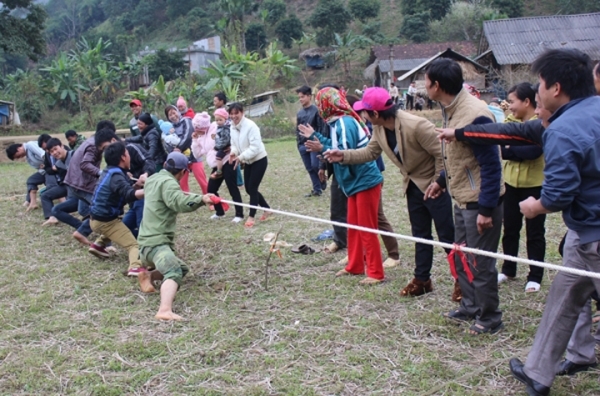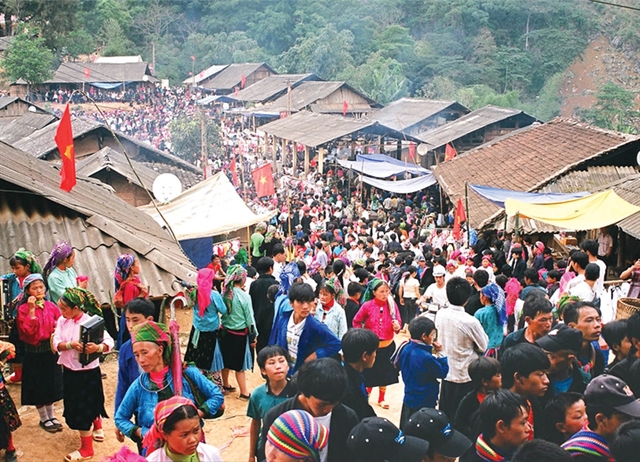 Life & Style
Life & Style

Local authorities in the northern province of Lào Cai have decided to develop tourism based on local ethnic cultures.
LÀO CAI — Local authorities in the northern province of Lào Cai have decided to develop tourism based on local ethnic cultures.
“Local ethnic cultures are considered a key to encourage the province’s socio-economic development,” said Hà Văn Thắng, director of Lào Cai Province’s Culture, Sports and Tourism Department.
According to the province’s plan to develop culture and sport in 2016-20, preserving and developing ethnic identity, improving people’s spirit and material lives is the key mission in order to establish new rural areas, smart urban areas and sustainably eradicate hunger.
Lào Cai is now ranked among top areas of the country with the most number of cultural heritages. The province hosts 26 intangible cultural heritages approved by the Ministry of Culture, Sports and Tourism.
The tug of war of the Tày and Giáy ethnic groups has been recognised by UNESCO as an Intangible Cultural Heritage of Humanity.

|
| Tug of war by local Tày and Giáy ethnic groups. — Photo thegoidisan.vn |
There are 45 relics and landscapes ranked as provincial and national relic sites.
Various landscapes have been upgraded to be safer and more attractive to tourists, like the complex site of Bảo Hà and Tân An temples; complex site of Upper Temple, Mother Temple and Đôi Cô Temple in Lào Cai City.
The province has gathered folk artisans with profound knowledge and skills on folk cultures. A total of 19 of them have been awarded the Meritorious Arts title by the State.
Artisan Ma Thanh Sợi has completed a study stretching over 2,000 pages in customs of local Tày group. Artisan Sần Cháng has hosted five studies on the culture of the Giáy group; three of the studies have won prizes by the Việt Nam Folklore Artisans’ Association.
Artisan Tẩn Văn Siệu of the Dao ethnic group has taught Nôm Dao characters to hundreds of students in Tả Phìn Commune, Sa Pa District. He has also taught folk songs to girls and women in the area. He has also collected ancient books of the group.

|
| Spring in Sa Pa. — Photo tourdulich-sapa.com |
Nông Đức Ngọc, head of the Lào Cai Ethnic Groups Department, said the ethnic values have been associated with tourism.
“Tourists have been very interested in local songs, rituals and lifestyle,” he said. “So we are trying to hand them down to young people.”
In the past few years, Sa Pa District has recovered some traditional handicraft trades by ethnic minority groups like embroidery weaving, planting medical herbs, making incense, making candles from beeswax, as well as making ornaments from silver and forging steel.

|
| Bắc Hà Market. — Photo huongsonsapa.com |
Sa Pa has been recognised as a National Tourism Site and welcomed more and more domestic and international tourists.
“Sa Pa has not only cottages and lanes,” said PM Nguyễn Xuân Phúc at a meeting with local leaders on December 6. “Sa Pa has also cultures of various ethnic groups. We preserve the ethnic culture as a long-term attraction to tourists on the foundation of a proper infrastructure for developing tourism. If Sa Pa loses the cultures, there is no longer a special Sa Pa.”
Various tourism products linking agriculture and eco-tourism in Lào Cai have been introduced recently, like flower farms with orchids and roses; tours to terrace rice fields at Mường Hoa Valley (Sa Pa District), Bắc Hà, Mường Khương and Bát Xát districts.
Farming tours to farms of strawberry, mushroom, orange, pearl and plum or to fish farms have also been popular.
Lào Cai has been among the first provinces in the country to apply community tourism models to reduce poverty for ethnic minority people. The two experimental models were in Bản Hồ and San Sả Hồ communes (Sa Pa District), which have been developed in Tả Van, Tả Phìn, Thanh Kim communes (Sa Pa District) and other districts like Mường Khương, Si Ma Cai, Bắc Hà and Bát Xát.
The community tourism models have steadily confirmed their trademarks. In 2016, homestay services in Bắc Hà District received the ASEAN Homestay prize while Tả Van Giáy 1 Homestay received the same prize in 2017.
In Sa Pa, the tourism product “A Day as a Farmer” has offered tourists a chance to work in the field, pick fruits and corn.
“The close co-ordination between authorities, folk artisans and people has proved the efficiency of preserving traditional cultures in modern times,” said Thắng. — VNS




